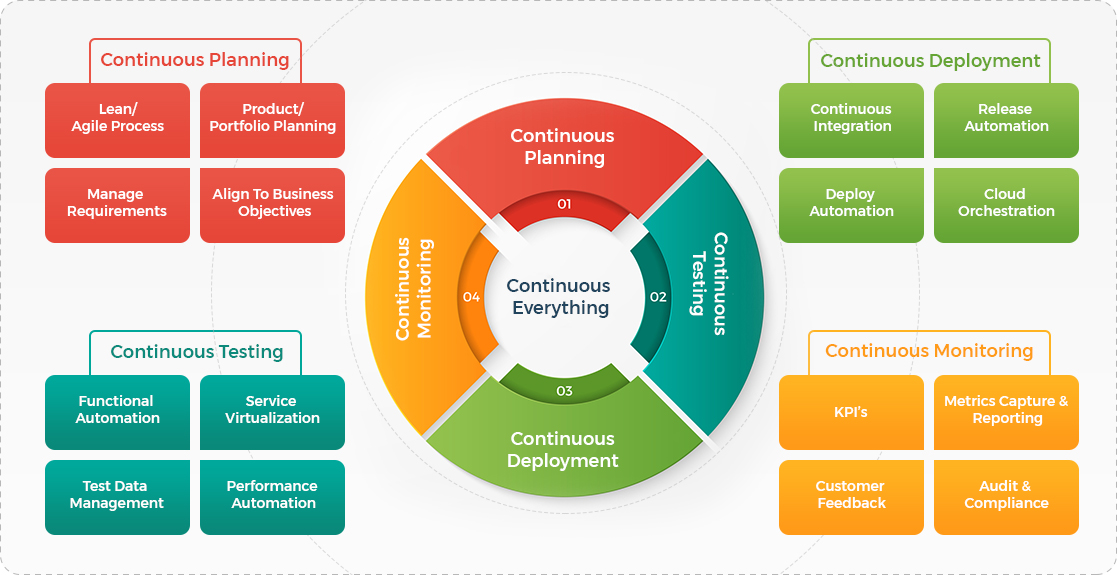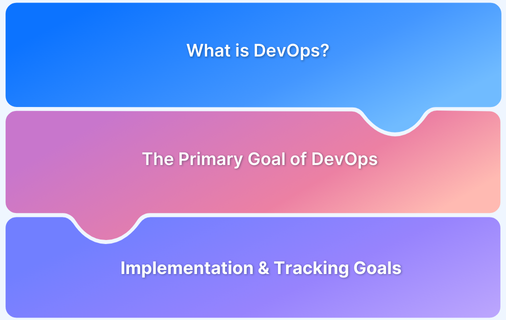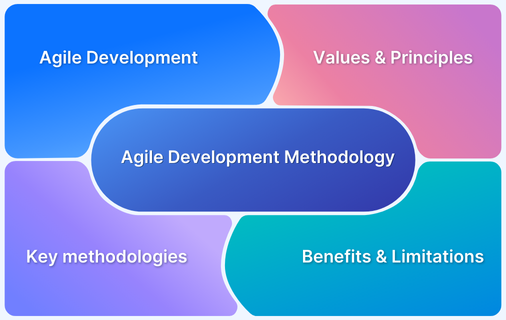Modern software delivery demands speed, flexibility, and quality. Scrum (an Agile framework) and DevOps (a cultural/technical practice) are two widely adopted approaches that share common goals—faster releases and continuous improvement—yet they differ in scope, roles, and implementation.
Overview
What is DevOps and When to Use It?
- Culture uniting Dev + Ops with CI/CD, automation, and monitoring.
- Best for fast releases, legacy modernization, and eliminating silos.
- Benefits: faster delivery, collaboration, responsiveness.
- Limitations: cultural shift, legacy hurdles, speed vs security.
What is Scrum and Where to Apply It?
- Agile framework with sprints, roles (PO, Scrum Master, Dev Team), and ceremonies.
- Ideal for volatile requirements and frequent client changes.
- Benefits: transparency, adaptability, quick deliverables.
- Limitations: scope creep, scaling issues, dependency on team stability.
How Scrum and DevOps Differ in Scope and Practice
- Focus: Scrum = collaboration & adaptability; DevOps = automation & pipeline speed.
- Artefacts: Scrum → backlogs & sprint goals; DevOps → deployment & library artefacts.
- Ceremonies: Scrum → sprint planning, reviews, retros; DevOps → system thinking, feedback loops.
- Roles: Scrum → PO, Scrum Master, Dev Team; DevOps → Evangelist, Release Manager, Automation Architect.
This article highlights Scrum vs DevOps differences in scope, artefacts, ceremonies, roles, benefits, and when to use each approach.
What is Devops
The DevOps philosophy combines Development and Operations together by implementing a set of tools and practices that eliminates the traditional divide between development and operations teams to help facilitate faster product delivery and keep the focus on maintaining software quality.
Must Read: A Beginner’s Guide to DevOps
Contrary to traditional software development models, it embraces the culture of Continuous Everything (Continuous Planning, Continuous Integration, Continuous Deployment, Continuous Delivery, Continuous Testing, and Continuous Monitoring) in order to be more responsive to change.

When is DevOps used
DevOps is not a methodology, but rather a comprehensive culture that needs to be embraced by the organisation as a whole. It is most critical to use DevOps when –
- The business scope requires regular releases and cannot afford the long wait times of traditional waterfall models to launch the product.
- The business is not satisfied by the current state of software process and seeks to overcome the challenges of wait times, miscommunication and friction caused by teams working in silos.
- The business seeks to shift from cumbersome legacy process and architecture to accelerate product release velocity
Also Read: How to Accelerate Product Release Velocity
Benefits of DevOps
The benefits of Devops implementation are as follows:
- Expedited development and application deployment
- Shorter response times to market changes
- Increased profits from having a shorter Time To Value (TTV) as software is released faster without compromising on quality
- Simplifies collaboration and keeps the entire team on the same page due to cross-functional team structures.
Limitations of DevOps
One of the most common qualms about implementing DevOps are the problems associated with prioritising speed over security. Some other issues are:
- Requires a cultural shift across the entire organisation in order to be fully effective.
- Legacy systems can pose a challenge to DevOps practices and must be overhauled to keep up with modern software engineering trends.
- It is somewhat difficult to obtain the right people with DevOps experience in order to make the process work
Must Read: DevOps Testing Strategy
What is Scrum
Scrum is a variation of Agile Methodology implementation that allows products to be built in a highly-volatile environment with development requests changing frequently. This process leverages short development cycles called sprints which last from two weeks to a month at max.
These teams are small and have between 3 to 9 members, including a scrum master and a product owner.
The process encourages constant communication between its members and seeks to maintaining the flow of development using ceremonies like the Daily Scrum (which is like a daily standup to discuss blockers, etc); sprint reviews (to demonstrate the work done to stakeholders) and sprint retrospectives (to understand what worked well and what parts to correct).
Scrum is the most popular methodology followed by Agile practitioners with 66% opting for scrum whereas 15% more opt for derivatives like Scrum/XP, and Scrumban as of 2021
When is Scrum used
Since Scrum has the power to accelerate software developments in highly volatile environments, it should be generally used when:
- The requirement definitions are not clearly defined
- When the client expects a high probability of change during the development process due to market changes, or changes in business goals and objectives
- When the general culture of the organisation requires flexibility and open communication to achieve business goals.
Benefits of Scrum
The many benefits of Scrum include:
- Helping teams achieve project deliverables quickly and efficiently while working in a volatile and agile environment
- Helps to divide large projects into easily manageable sprints.
- The scrum ceremonies provide transparency for all stakeholders involved, and help to highlight any blockers
- Short sprints are more manageable and can be customised to react to change in requirements.
Limitations of Scrum
No methodology, however efficient, can provide a silver bullet to the organisation’s problems. Some limitations of Scrum being:
- The propensity for scope creep, due to the lack of a definite end-date
- Challenges in adopting scrum for large teams as it becomes difficult to have many people on the same page
- There are risks when team members leave in between a Scrum process as it negatively impacts the entire cycle.
- Product quality often takes a hit as the focus on smaller sprints is on code delivery and there may not be enough time or resources to effectively maintain a robust QA process.
DevOps vs Scrum: Core Differences
The core differences between Scrum and DevOps are discussed in the section below.
Scope
Scrum and DevOps both seek to create processes that are more responsive to change.
Scope of Scrum
Scrum teams gain experience as they work and adjust to fluctuating conditions, e.g. mid-way requirement changes
Short release cycles enable re-prioritization and drive continuous learning and development
Scope of DevOps
It helps break down differences between Developers and Operations teams and creates robust communication and feedback channels. Its scope is more towards leveraging cross-functional expertise to respond to fluctuations in customer demands.
Artefacts
Scrum and DevOps have a different approach to the artefacts whose details are mentioned below:
Artefacts of Scrum
- Product Backlog is the masterplan for the sprints. Essentially it is a to do task for the product and can be reprioritized based on new information or changes
- Sprint backlog lists down the items to be achieved in the current sprint cycle. This can evolve as the sprint goes on but should not deviate from the Sprint Goal.
- Sprint Goal is the tangible output of the sprint and results in an end-of-sprint demonstration to the stakeholders.
Artefacts of DevOps
- Deployment Artefacts include the executable files released for user consumption like deb, rpm, exe, etc. Github Releases is a popular platform for these.
- Library Artefacts are similar to deployment artefacts but used in further development processes. They are often stored in destinations like NPM, Maven, NuGet, and pip.
- Bundle Artefacts group several other artefacts together. They are not stored in repos, but in drop-zones like VM’s or Cloud Storage.
Ceremonies
Both Scrum and DevOps depend on a certain number of ceremonies to provide structure to the process.
Ceremonies in Scrum
- Backlog organization: It is overseen by the product owner and drives the delivery of the product vision by taking market trends and customer feedback into consideration.
- Sprint Planning: It scopes out the current sprint and creates a roadmap for getting to the sprint goals. This is led by the Scrum master and requires the entire dev team to be in attendance.
- Sprint: Typically between two weeks to a month, this provides the window for teams to work towards a determined sprint goal.
- Daily Scrum: Or Stand-Up meetings ensure that everyone is in sync with the sprint goal and any blockers are highlighted.
- Sprint Review: This is for demonstrating the sprint goals to the stakeholders at the end of the sprint.
- Sprint Retrospective: This happens at the end of the sprint where the team gets together and looks at what worked and what didn’t
Ceremonies in DevOps
- System Thinking: It deals with the performance of the work environment as opposed to that of a particular team or silo. This is aided by Continuous Delivery by automating the flow of the process from conception to deployment.
- Leveraging Feeback loops: It amplifies this process by reducing wait time due to lengthy communication between teams. This is achieved by Continuous Monitoring.
- Incremental Experimentation: To help modify and optimise the parts of the pipeline and achieve better results by the sum of parts rather than undertaking massive overhauls of the pipelines as a whole.
Essential Roles
Both Scrum and DevOps have certain roles that are essential to run the process successfully.
Essential Roles of Scrum
- Product Owners: They focus on a deep understanding of the business and customer requirements and help in prioritising the tasks in sprint and product backlogs.
- Scrum Masters: They act as an expert on the Scrum process and coach product owners, development teams, and business stakeholders in order to achieve transparency and expedite product delivery
- Development Team: They look after the day to day operations of the team.
Essential Roles of DevOps
- DevOps evangelist: They take charge of the ownership and delivery during a DevOps transformation. They promote the benefits of DevOps and allocate roles and responsibilities to the other team members
- Code Release Manager: They are akin to a project manager. This person leverages technical expertise needed for running and maintaining the application development and delivery processes
- Automation Architect: They optimize DevOps pipelines using automation.
- Experience assurance executive (XA): They are spokesperson for the end user and promotes a smooth UX for the final product. They are in charge of the overall QA.
- Software developers and testers work in close collaboration to implement CI/CD and Continuous Testing
- Security and compliance engineer (SCE): They look after system security and can be leveraged to evolve DevOps to DevSecOps
| Feature | Scrum | DevOps |
|---|---|---|
| Scope | Scrum is a heuristic framework that stresses on continuously learning and plugging in knowledge gaps. | DevOps creates a culture of improved reactivity to production issues by eliminating overspecialization and silos in organisations. |
| Artefacts | The main scrum artefacts are:
| Devops has a number of build artefacts which need different pipeline and coding techniques for deployment and production. These are namely Deployment, Bundle, and Library Artefacts |
| Ceremonies | The main ceremonies of Scrum are:
| The three main ceremonies in DevOps are:
|
| Essential Roles | The Scrum team emphasises 3 critical roles:
| The DevOps culture requires the following roles:
|
| Benefits |
|
|
| Implementation | Implementing Scrum can be achieved as shown below :
| Implementing DevOps calls for a wholesale culture shift. This can be done in the following stages
|
On a Closing Note
Both Scrum and DevOps are essential to bringing about a shift from cumbersome and inflexible traditional development models. They both focus on collaboration, incremental “fail fast” philosophies, and faster product delivery though their specific focus and ways of implementation are somewhat different.
Regardless of whether an organisation used Scrum or DevOps for software delivery, it is absolutely essential to test on real devices for getting the best results. Tests conducted on Emulators/Simulators are also not ideal as they fail to replicate real time conditions. BrowserStack Automate and App Automate allow integrations with DevOps tools like Azure DevOps and lets users execute tests using Selenium, Appium, etc on 3000+ cloud based devices.
Agile practices like Scrum require tests to be done across multiple Browser-OS-Device combinations and BrowserStack Live for Team allows remote teams to do exactly the same across 3000+ real devices.





